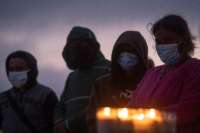The ‘hostile environment’ for irregular migrants in the UK is designed to make life as difficult as possible. Successive Home Secretaries defend it as a tough but necessary means of controlling Britain’s borders, but does the hostile environment really serve its stated purpose? Is it possible that lives are being ruined for no reason?
Under the Immigration Act 2014, the ‘right to rent’ scheme imposes criminal sanctions on landlords who do not take measures to avoid letting property to irregular migrants. In Secretary of State for the Home Department v The Queen on the Application of the Joint Council for the Welfare of Immigrants (2020), the Court of Appeal accepted that the scheme had caused landlords to discriminate on the basis of tenants’ perceived nationality and race. The Court did not, however, find this to be unlawful; it considered it “a proportionate means of achieving its legitimate objective and thus justified” (§151).
The scheme’s objective was broadly defined as “being to support a coherent immigration system in the public interest” (§113), but the Court failed to clarify what it meant by ‘support’. The scheme is not designed to assist in identifying or locating people unlawfully present. It is part of a strategy which aims “to encourage those already [in the UK] to leave voluntarily” (House of Commons Home Affairs Committee 2018, p.20). It is my contention that the scheme does not pursue a legitimate objective, and thus its discriminatory consequences cannot be lawfully justified.
For many irregular migrants, repatriation is simply not a viable option. Brad K Blitz and Miguel Otero-Iglesias (2011) have estimated that approximately 90% of failed asylum seekers remain in the UK after refusal. It is difficult to estimate how many have compelling reasons not to return to their countries of origin, but refugee law scholars have repeatedly expressed concerns that states encourage ‘voluntary’ repatriation “even when it is not appropriate” (Chimni 1998, p.543).
Even where repatriation is possible, it simply does not follow that the Home Office is justified in actively discriminating and denying the rights of irregular migrants. There can be little doubt that the scheme is discriminatory by design; the Court differentiates clearly between “irregular immigrants whose right to rent was deliberately curtailed by the Scheme” and its “unintended discriminatory consequences” for others (§4). Such differentiation compounds the discrimination experienced by irregular migrants under the scheme; they are excluded not only from the right to access housing, but from the right to freedom from discrimination – indeed, they are excluded altogether from what Hannah Arendt called ‘the right to have rights’. Marie-Bénédicte Dembour has termed such exclusion “the ultimate discrimination” by which irregular migrants are denied the protection of law and rendered de facto stateless (Dembour 2015, p.443-446).
The Court also fails to seriously examine the lawfulness of such differentiation, which remains contentious. The Inter-American Court of Human Rights considers it jus cogens that, whilst states may legitimately differentiate between the benefits available to those with regular and irregular status, “Basic human rights must be respected without any distinction” (2003, p.24). Indeed, in the Right to Rent case itself, Lord Justice Hickinbottom comments that “I cannot accept the concept of an individual acting ‘rationally’ or ‘logically’ by taking a course of action which, whilst being in his own interests, is to his knowledge discriminatory and unlawful” (§69). This relies on a peculiar circular logic, by which only ‘lawful’ discrimination may have a rational justification (itself a necessary precondition for lawfulness).
The Court further accepted that the scheme was “rationally connected to the objective” of supporting a coherent immigration system (§113). It is beyond the scope of this text to evaluate the general effectiveness of deterrent or punitive measures in controlling immigration. Nonetheless, I maintain that there are further errors of reasoning contained within this brief statement.
Firstly, it is not alleged that all those targeted are able to repatriate. If they are not, it stands to reason that the scheme cannot encourage them to do so. I reiterate that many irregular migrants have extremely compelling reasons not to return to their countries of origin. By this I refer not only to ‘mere’ economic concerns; leaving the UK can be a matter of life and death, even for those who do not qualify for asylum (Dembour 2015).
Secondly, even if the scheme may in fact achieve its objectives, it does not necessarily follow that it is a rational method of pursuing them. There will be people affected by the scheme who can and do repatriate as a result, but the scheme does not uniquely penalise irregular migrants; it penalises racialised minorities more generally (§4). There is every reason to believe that people with regular migration status may equally be encouraged to repatriate. The ‘achievements’ of the policy in deterring unlawful presence are almost accidental; it is as indiscriminate as it is discriminatory, and its various consequences result in substantially the same way.
It is worth contemplating briefly what the consequences might be for those who do not or cannot repatriate. Irregular migrants and other racialised minorities who struggle to access legally rented accommodation may be increasingly vulnerable to criminal financial exploitation and domestic violence, concerns which are particularly acute when viewed in conjunction with other measures impacting access to healthcare, policing etc. The damage caused by the hostile environment is widely known and much reported, but if it serves no rational purpose, there is no question of proportionality. It is my sincere hope that the Supreme Court will declare this scheme unlawful on appeal and cease to legitimise suffering for the sake of suffering.
References
Arendt, Hannah. (2017). The origins of totalitarianism (Penguin modern classics). Penguin.
Blitz, B. K. & Otero-Iglesias, M. (2011). Stateless By Any Other Name: Refused Asylum-Seekers in the United Kingdom. Journal of Ethnic and Migration Studies (37).
Chimni, B. S. (1998). The Geopolitics of Refugee Studies: A View from the South. Journal of Refugee Studies, 11(4), pp. 350-384.
Dembour, M. (2015). When Humans Become Migrants: Study of the European Court of Human Rights with an Inter-American Counterpoint. Oxford University Press.
Immigration Act 2014 c. 22.
Inter-American Court of Human Rights, (2003). Juridical Condition and Rights of Undocumented Migrants, Advisory Opinion OC-18 of 17 September 2003.
Qureshi, A., Morris, M. & Mort, L. (2020). Access Denied: The Human Impact of the Hostile Environment. Institute for Public Policy Research.
Secretary of State for the Home Department v The Queen on the Application of the Joint Council for the Welfare of Immigrants (2020) Court of Appeal, Civil Division, case 542.
UK House of Commons Home Affairs Committee. (2018). Immigration Policy: Basis for Building Consensus. Available at: https://publications.parliament.uk/pa/cm201719/cmselect/cmhaff/500/500.pdf .
This post was originally published on LSE Human Rights.






